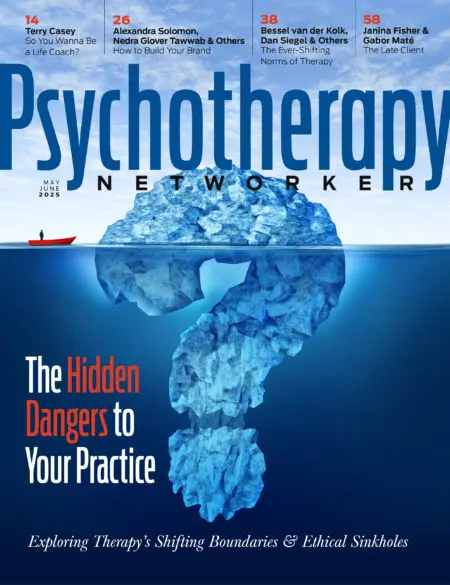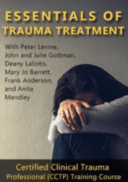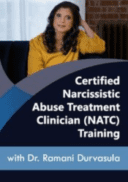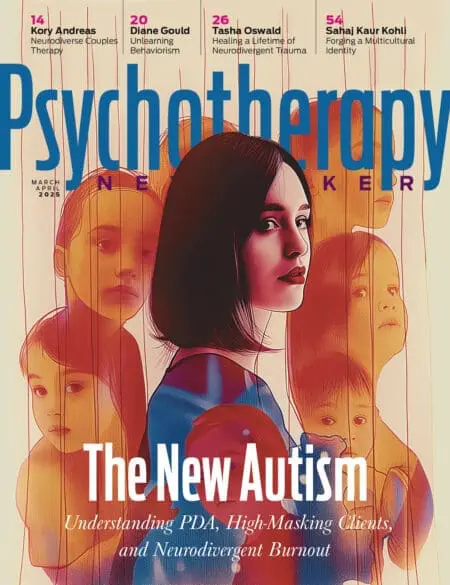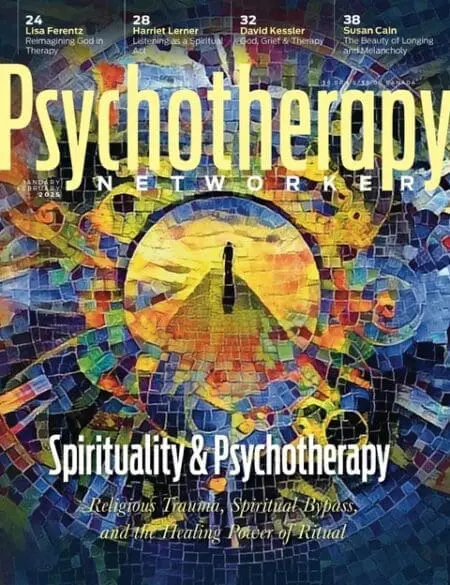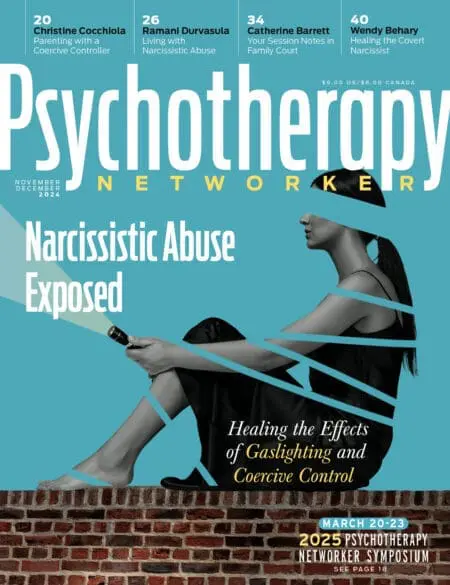Ahh, 2025. A new year! A chance to shake off the rust, leave the December doldrums behind (we can think of a few things we’d rather forget!), and charge bravely over the horizon. But what lies ahead? When it comes to your practice and the future of the field, the last thing you need is more uncertainty. Well, it may not exactly be soothsaying, but we drummed up the next best thing: we sat down with five therapy superstars, including Steve Hayes, Ruth Lanius, and Nadine Burke Harris—each with an ear to the ground in their respective fields—and got the inside scoop on the hot clinical developments you won’t want to miss in the coming year.
Nadine Burke Harris on the Revitalization of Trauma-Informed Care
Will We Resist the Urge to Return to Business as Usual?
Former California Surgeon General Nadine Burke Harris predicts that 2025 will bring a lot more talk about trauma, particularly childhood trauma.
As a pediatrician and public health clinic founder, Burke Harris has spent nearly two decades studying adverse childhood experiences (ACEs) and the toxic stress response, which refers to the prolonged activation of the biological stress response that disrupts brain structure and function, hormonal systems, the immune system, and even the way that DNA is read and transcribed. Over the years, she and her team have trained more than 40,000 healthcare providers on how to screen for ACEs and respond with evidence-based, trauma-informed care.
In 2025, she hopes more people will effectively mobilize against ACEs. That means more primary care physicians will be able to handle early detection—and loop in more therapists to assist with treatment. “Therapists create the time and space to unpack which ACEs a patient has experienced, how it’s impacting their mental and behavioral health, and what to do about it.” Which begs the question: what’s the most effective intervention for addressing the dysregulated biology that results from ACEs? Is it a new med? Or perhaps a flashy piece of wearable tech?
Neither, actually. Burke Harris says that good old child-parent psychotherapy is a perfect intervention, and that it’s experiencing a renaissance for this reason. “The research shows that it not only improves outcomes for young children when it comes to distress, anxiety, and attachment, but that it can actually improve genetic markers of stress reactivity,” she explains.
“In 2010, I traveled to Haiti as part of a relief mission after the earthquake,” she shares. “Some of the buildings were still standing, and looked safe on the outside, but they were seismically unsafe. If we don’t want to deal with even bigger problems downstream, now is the time for a seismic retrofit in terms of how we’re treating childhood trauma. I’m seeing a lot more communication between primary care and mental health providers,” she says, “and that’s a great place to start.”
Ingmar Gorman on the Psychedelics Rematch
After a Series of Setbacks, Will MDMA and Psilocybin Finally Find a Foothold?
For a good while, it felt like 2024 might be The Year of the Psychedelic—until it wasn’t. Last summer, numerous media outlets (including this magazine) held their breath as biopharmaceutical company Lykos bandied with the FDA, eagerly awaiting the coronation of MDMA-assisted therapy as a legal treatment for PTSD. Anticipating good news, clinicians flocked to psychedelic-assisted therapy trainings, and patients felt a bright hope for a new treatment option. Then, in August, the sobering news arrived: it’s a no-go, said the FDA.
Well, not a total no-go. According to the FDA’s response, more research on safety and efficacy is needed. And in 2025, psychologist Ingmar Gorman speculates, Lykos will figure out how to address those shortcomings and regroup for another—hopefully more fruitful—round of FDA deliberations. Gorman, who trains mental health providers in psychedelic treatments as the co-founder of psychedelic education company Fluence, notes that a key factor in creating more convincing data will be determining what role therapists might play in MDMA-assisted psychotherapy.”
Wait, the FDA cares about therapy? Yup.
“It’s fascinating to me,” Gorman says. “The FDA is stepping into a debate that’s been in psychotherapy for 40 years, except they don’t use terms like evidence-based practice or empirically supported treatment. They think more along the lines of the current standard of care.” Will the psychedelic-assisted therapy research hinge on using something seemingly complementary with MDMA, say, a nondirective approach, or will a treatment like prolonged exposure be used? “That’s a big question,” Gorman says. “And I think in 2025, Lykos will have a protocol that determines what the study looks like.”
But plot twist: the first big psychedelic to get FDA approval may not be MDMA after all, but psilocybin. A number of drug companies, most notably Compass Pathways and Cybin, both of which have been studying psilocybin for depression, will likely be submitting the results of their own Phase Three studies for FDA approval soon. Keep your eyes peeled, Gorman says.
In the meantime, it’s tempting to view the FDA as an annoying speed bump en route to greenlighting what many study participants, covert clients, and more than a few therapists have found to be a life-changing experience. But Gorman says it’s important to keep in mind that all this caution and protocol is in the interest of public safety.
“There are companies that say psychedelic-assisted therapy comprises a synergistic effect between the psychotherapy and the drug,” he explains. “Then there are other companies that don’t include psychotherapy or psychological support, even though there might be therapists monitoring in the study room. My worst nightmare is that a psychedelic would get approved with the bare minimum ‘monitoring,’ and then outside the lab, people won’t experience benefit—or may even be harmed because they’re not getting enough support alongside it. This will be addressed by research, but in my view, it’s quite risky.”
Ruth Lanius on the Promise of Stabilization
How Will We Address One of the Hardest Parts of Trauma Treatment?
According to trauma expert Ruth Lanius, a scientist at the London Health Sciences Centre Research Institute and a psychiatrist at the London Health Sciences Centre who’s been studying trauma for almost 30 years, the key to effective trauma treatment is helping clients reach a mind-body state where they can begin to absorb the treatment—“grounding and stabilization,” as she calls it. And she says the momentum around several stabilization interventions will continue to grow in 2025. “We’re at an incredibly exciting point in our field,” she says. “I’m seeing more trainings about stabilizing and grounding before delving into the deepest pain of trauma than ever before. It’s the most excitement I’ve witnessed in my entire career.”
Lanius says one of the most common ways to stabilize a client is to help them “find solid ground.” Most therapists know it’s important to help clients “ground,” but don’t focus enough on it. Trauma survivors are naturally fearful and resistant to grounding since they use detachment as a survival mechanism. “But if you’re disconnected from your feelings and your body, you can’t pick up on danger,” she explains. “We help clients understand that grounding will help them feel safe, that it’s the only way to be truly safe in the world.”
Lanius is particularly excited about the use of videos for stabilizing and grounding interventions. “In our studies, we found that people would go back to their videos over and over again,” she says. “It makes sense: when you’re highly dissociative, you often don’t remember what went on in session. We got feedback from some clients that they’d return to their videos at two in the morning!”
Then, there’s neurofeedback, another intervention that can be used for stabilization. “Neurofeedback brings us home to what trauma is really about,” Lanius says. “Trauma has adapted the brain, which controls the body, so survivors live with the feeling of inescapable threat.” But neurofeedback targets those brain adaptations directly, Lanius adds, quieting the brain and guiding it to safety—a feeling most traumatized brains have never known. “When you experience trauma, you’ve lost all control,” Lanius says. “But when you’re changing how your brain is firing, second by second, you start to feel like you’re in control again.”
These stabilization techniques don’t just streamline therapy for clients, Lanius says. They make it smoother for therapists, too. “These are complex individuals,” Lanius says of the clients. “Many engage in self-harm, or substance use, or they’re severely depressed, suicidal, or dissociative. It’s a population that can make us feel helpless and hopeless.” But stabilization and grounding techniques, she adds, reduce all of these symptoms—and increase self-compassion, which she calls a critical part of reducing the shame and self-loathing that so often accompanies trauma.
Could stabilization and grounding be the shot in the arm that trauma therapy’s been missing? Lanius thinks so. “You can feel the collective excitement around this,” she says. “People have had profound experiences that are propelling these treatments. There’s interest, and there’s hope.”
Steve Hayes on Rethinking Everything You’ve Been Told About Diagnosis
Tearing Down the DSM, Treating the Individual, and Why We’re Losing Therapists to Coaching
When it comes to the DSM, Steve Hayes doesn’t mince words: “When I say I want to kill it, 90 percent of clinicians agree,” he says. “Signs and symptoms and syndromes are so yesterday.”
As a clinical psychologist, professor of psychology emeritus at the University of Nevada, and the co-developer of acceptance and commitment therapy (ACT), you might think Hayes has his hands full. But even at 76, he remains committed to a singular mission: “I’ve spent 40 years trying to hack the human mind,” he says, “trying to do the most good for the most people.”
At the forefront of Hayes’s hackathon has been an effort to take down the much-maligned DSM—and to put in place a fresh, client-centered, whole-person model that does more than boil clients down to walking, talking bundles of symptoms. We’re long overdue for such a model, Hayes says. But hey, he adds, 2025 is as good a year as any for it to catch fire.
“We need to prioritize bio-psycho-social change processes instead,” Hayes says of his ideal diagnostic model. “Whether you’re talking about healthy attachment or emotional acceptance abilities or being able to form healthy relationships or the therapeutic alliance, these are all processes of change.”
So what does this look like in therapy? It’s simple, Hayes says. “We need to ask our clients what the heck is going on in their lives. We help them learn how to be more open, aware, and actively engaged in a meaningful life, extending that to their relationships and taking care of their bodies. Then, those processes need to be focused on where they will do the most good.”
One way Hayes is championing this process-based vision is by making the body more central in treatment. For example, he says, between 15 and 25 percent of adults have ringing in their ears, and a quarter to a half are significantly distressed by it. Many say it’s the most distressing thing in their lives. But this is information they’ll rarely share with a therapist, nor will clinicians ask about it, because as far as they’re concerned, it has nothing to do with therapy. “But of course it does,” Hayes explains. “And research shows we can apply the very processes that help someone with anxiety or substance abuse to the ringing in their ears, or the pain in their foot, or the limitations they’re facing because of an injury or cancer.”
Is a seismic diagnostic shift underway? Hayes thinks so. More therapists and clients are beginning to think outside the diagnostic box—or jumping ship entirely. “This is why so many therapists want to be coaches,” he adds. “They don’t want to put people inside tiny little boxes.” A therapist may not be a pain expert, Hayes says, but they can help the client redirect attention from the pain. They can ask about sleep, or diet, or exercise when doing intakes. As for clients? “They want to stand up during sessions and do something physical. We’re already beginning to see a move toward the holistic. It’s a natural extension of what we do.”
Steve Duke on the Hope for Teletherapy Apps
As Tensions Over Pay, Support, and Mission Come to a Head, What’s Next?
There’s a popular stereotype when it comes to teletherapy apps: they’re morally corrupt juggernauts run by shadowy suits and slick, Silicon-Valley tech bros who prey on fresh-out-of-grad-school therapists and pay them a pittance, reducing the art and soul of therapy to ones and zeroes.
Steve Duke doesn’t contest that there are flaws in how some teletherapy companies run their business. Yes, in many cases, therapists’ grievances over pay, workload, and company ethics are justified. But the truth, he says, is less black and white—and in 2025, therapists and these organizations may finally find common ground.
“All the books on my bookshelf are about mental health,” Duke tells me. “I find it fascinating.” It’s unsurprising for someone who was transformed by therapy after being diagnosed with OCD at age 11. Years later, after working in the health tech space, Duke decided to apply his knowledge toward the profession that changed his life as a young boy. Today, he manages and writes for The Hemingway Report, an online publication that tracks the business happenings in the mental health world, including those involving therapy apps.
Historically, therapists on these apps have felt disempowered, Duke says. “There’s been a lot of tension bubbling under the surface for quite some time.” But he also says he’s excited and hopeful that this tension will get resolved soon. “I think these platforms are starting to understand just how important therapists are to their business,” he says. “They’ve experienced the pushback from parts of the therapy community, and the more forward-thinking ones are starting to change their behavior, whether through better compensation or provider tools, like scheduling or note-taking functions that make it easier for them to do their work—which will also be good for clients.”
But Duke says some teletherapy platforms are going a step further, providing services he playfully refers to as “a therapy practice in a box”—so that therapists can get their own businesses off the ground, practice the type of therapy they want to practice, and see the kinds of clients they’re most interested in supporting. “Companies that promote this kind of therapist empowerment are growing rapidly,” Duke says. “It’s a really interesting trend.”
Will other companies continue to take advantage of clinicians just trying to make ends meet? Sure, Duke says. “I definitely see some of these companies lacking adequate clinical guidance. And we should hold them accountable. But we shouldn’t paint all therapy businesses with the same brush. We should be assessing them based on their actions and outcomes, whether they’re doing the right thing for clinicians and patients.”
Tension between therapists and platforms will linger in the year ahead, Duke anticipates, but he’s hopeful we’ll be hearing more positive stories too. “I see a bunch of organizations taking different approaches to support their therapists, and many of those therapists are happy. That gives me hope,” he says. “They’re putting clinicians first: they have them as cofounders and on their leadership teams. Therapists are speaking up about what isn’t working, and many of these businesses are listening. They have to. As long as people are talking to each other, I’m hopeful that things will get better.”
Chris Lyford
Chris Lyford is the Senior Editor at Psychotherapy Networker. Previously, he was assistant director and editor of the The Atlantic Post, where he wrote and edited news pieces on the Middle East and Africa. He also formerly worked at The Washington Post, where he wrote local feature pieces for the Metro, Sports, and Style sections. Contact: clyford@psychnetworker.org.
